Atlanta selvagensis
Roger R. SeapyIntroduction
Atlanta selvagensis is a small species (<2.0 mm shell diameter). The shell is transparent except for the keel base, which is yellow-brown to brown, and the spire sutures, which are reddish-brown (magenta). The keel is tall, truncate along its leading edge, and it does not insert between the penultimate and last shell whorls. The shell spire is low conical, usually consisting of 3-1/2 to 3-3/4 whorls. Spire whorl ornamentation is highly variable, ranging from none to fully developed; in the latter case, evenly-spaced spiral ridges are present on the second through fourth whorls. Eyes type a, operculum type c, and radula type I. The species is found in tropical to subtropical waters of the Atlantic and Indian Oceans. Except for the number of whorls comprising the shell spire and the presence of suture coloration, A.selvagensis shares other morphological features with A. inflata from the Pacific Ocean (see the Atlanta inflata page).
Diagnosis
- Maximal shell diameter <2 mm
- Shell transparent except for a yellow-brown to brown keel base and reddish-brown (magenta) spire sutures
- Keel tall, with a truncate leading edge
- Keel does not penetrate between penultimate and last shell whorls
- Shell spire usually consists of 3-1/2 to 3-3/4 whorls
- Spire whorls with evenly-spaced, raised spiral ridges (beginning on the second whorl) variably expressed and ranging from none to fuly developed
- Eyes type a
- Operculum type c
- Radula type I
Characteristics
- Shell
- Shell small, with a maximal shell diameter (excluding the keel) of 2.0 mm
- Keel tall with a truncate leading edge
- Keel never inserts between penultimate and last shell whorls
- Spire low conical, usually consisting of 3-1/2 to 3-3/4 whorls, although shells from the North Atlantic occasionally have 3-1/4 and, rarely, 4 whorls (Janssen and Seapy, 2009)
 Click on an image to view larger version & data in a new window
Click on an image to view larger version & data in a new window

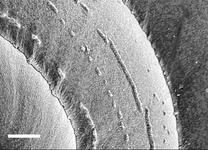
Figure. Scanning electron micrographs of the right side of the Atlanta selvagensis shell; whole shell at low magnification (left), shell spire at high magnification (center), and a portion of the third spire whorl (at about 2-1/4 whorls) to illustrate the broken spiral ridges of a Selvagens Island specimen (right). Scale bars = 0.5 mm (left), 100 µm (center), and 10 µm (right). Original images of A. de Vera modified by the addition of scales bars. © 2005 Alejandro de Vera
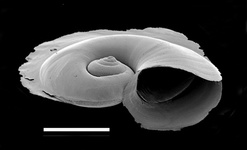
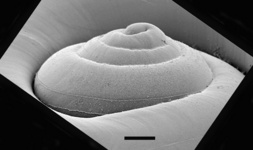
Figure. Scanning electron micrographs of the shell (left) and shell spire (right) of Atlanta selvagensis, viewed from the right side at about a 75° tilt. Scale bars = 0.5 mm (left) and 100 µm (right). Original images of A. de Vera modified by the addition of scales bars and by a 45° clockwise rotation of the second image. © 2005 Alejandro de Vera
- Shell transparent, except for the yellow-brown to brown keel base and the reddish-brown (magenta) spire sutures (see title illustration and photographs below)
 Click on an image to view larger version & data in a new window
Click on an image to view larger version & data in a new window

Figure. Photographs of Atlanta selvagensis at about a 45º (left) and 75° (right) tilt to illustrate the reddish-brown (magenta) coloration of the spire whorls and the yellow-brown keel base. In apertural view (right) the conical shape of the spire is nicely profiled. © 2005 Alejandro de Vera
- Eyes type a; distal pigmented tissues lacking a transverse slit
- Operculum type c or monogyre (see color photograph by A. de Vera below left). For comparison, a black and white photograph (from Richter, 1961) is included of an operculum from A. inflata (= A. selvagensis) collected from the North Atlantic.
 Click on an image to view larger version & data in a new window
Click on an image to view larger version & data in a new window

Figure. Photographs of the type c operculum of Atlanta selvagensis (left) and A. inflata (= A.selvagensis) from Richter (1961, Fig. 17b) (right). Color photograph cropped and gyre details enhanced from original by A. de Vera. © 2005 A.de Vera (left) and G. Richter (right)
Comments
Atlanta selvagensis was described in 2006 based on eight specimens collected in September 2000 by staff of the Museum Scientiarum Biologicarum Canariensium, Tenerife, Canary Islands from waters around the Selvagens Islands. Vertical tows to 500 or 1,000 m were taken with a triple net system (mouth opening = 0.25 m2). While assisting A. de Vera with the identification of the atlantids from these collections, R. Seapy was not able to identify one of the species; he found that it was closest in appearance to the Indo-Pacific A. plana. Like A. plana it had distinctive reddish brown sutures and limited (but more variable) numbers of spiral ridges on the shell spire. However, it lacked the unique gyre spination on the operculum seen only in A. plana; its keel was tall with a truncate leading edge (moderately low and rounded in A. plana); and the largest shell was only 1.5 mm in diameter (to 3.0 mm in A. plana). The species with which it was most similar, A. inflata, was not considered a possibility because it has been universally regarded as a cosmopolitan species (dating back to the 1908 systematic revision of the genus Atlanta by Tesch) and, in the atlantid fauna of the Hawaiian Islands studied by Seapy, A. inflata was shown to lack spire suture coloration and to have a spire consisting of 4-1/4 to 4-1/2 whorls; instead of the 3-1/2 to 3-3/4 whorls seen in the unidentified species (see the Atlanta inflata page).
In 2008 Arie Janssen was attempting to identify the atlantid shells collected from bottom samples in the North Atlantic and Mediterrancean Sea. He was confounded by a problem with the identification of a number of specimens that he couldn't distinguish between Atlanta inflata (as described previously by other European authors) and A. selvagensis (in the species description by de Vera and Seapy, 2006). Janssen and Seapy had been communicating by e-mail for several years previously about taxonomic issues in the genus Atlanta, and in 2008 Janssen began to suspect that the shells of A. selvagensis and those he had tentatively identified as A. inflata belonged to the same species. In agreement with the description of A. selvagensis, his shells were small (to 2.0 mm), had a tall keel with a truncate leading edge, and had a spire of about 3-1/2 to 3-3/4 whorls. These observations subsequently led to the conclusion by Janssen and Seapy (2009) that: (1) the species described as A. inflata by Soulyet in 1852 from the northwestern Pacific and characterized from Hawaiian waters by Seapy in 1990, was restricted to the Pacific Ocean (see the Atlanta inflata page), and (2) that those specimens previously identified as A. inflata from the Atlantic and Indian Oceans was a different species, which (4) should henceforth be attributed to A. selvagensis.
One aspect of the study by Janssen and Seapy (2009) that is peculiar is the geographic distribution of A. selvagensis. Because of the connection of the Pacific and Indian Oceans between southeast Asia and northern Australia, exchange of waters between the two oceans would, hypothetically, enable planktonic species to range across both oceans. Thus, the Indo-Pacific distributions of three species of Atlanta (A. echinogyra, A. plana, and A. turriculata; Richter and Seapy, 1999) are not surprising. However, among all species of heteropods, only A. selvagensis appears to occur in the Atlantic and Indian Oceans. The presence of A. inflata (= A. selvagensis) in the Indian Ocean was documented by Richter (1974). His scanning electron micrographs of the right side of the shell (see below) clearly illustrate the characteristic spire consisting of 3-3/4 whorls, the presence of spiral ridges on the spire whorls, a small shell (<2 mm), and a tall keel with a truncate leading edge.


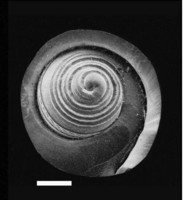
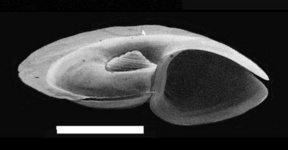
Figure. Scanning electron micrographs of the shell of Atlanta inflata (= A. selvagensis) from the northwestern Indian Ocean, modified from scans of the original images of Richter (1974, Plate I, Fig.4) with scale bars added based on magnification data. Views are of the right side of the whole shell (left), the shell spire (center) and at about a 75° tilt (right). Scale bars = 0.5 mm (left and right) and 100 µm (center); all added to the scanned images. © 1974 G. Richter
References
de Vera, A. and R. R. Seapy. 2006. Atlanta selvagensis, a new species of heteropod mollusc from the northeastern Atlantic Ocean (Gastropoda: Carinarioidea). Vieraea 34: 45-54.
Janssen, A. W. and R. R. Seapy. 2009. On the identity and distribution of Atlanta inflata Gray, 1850 (Gastropoda, Pterotracheoidea, Atlantidae) in the world's oceans. Basteria 73: 139-157.
Richter, G. 1974. Die Heteropoden der "Meteor"-Expedition in den Indischen Ozean, 1964/65. "Meteor" Forschungs-Ergebnisse (D) 17: 55-78.
Richter, G. and R. R. Seapy. 1999. Heteropoda, pp. 621-647. In: D. Boltovskoy (ed.), South Atlantic Zooplankton. Backyus Publishers, Leiden.
Seapy, R. R. 1990. The pelagic family Atlantidae (Gastropoda, Heteropoda) from Hawaiian waters: a faunistic survey. Malacologia 32: 107-130.
Souleyet, L. F. A. 1852. Heteropodes, pp. 289-392. In: J. F. T. Eydoux and L. F. A. Souleyet, Voyage autour du monde exécuté pendant les années 1836 et 1837 sur la corvette 'La Bonite', commandée par M. Vaillant, capitaine de vaisseau, publié par ordre du Gouvernement sous les auspices du Département de la marine. Zoologie, 2. Atlas. A. Bertrand (ed), Société de Géographie, Paris.
Tesch, J. J. 1908. Systematic monograph of the Atlantidae (Heteropoda) with enumeration of the species in the Leyden museum. Notes from the Leiden Museum 30: 1-30, 5 plates.
About This Page

California State University, Fullerton, California, USA
Correspondence regarding this page should be directed to Roger R. Seapy at
Page copyright © 2010
 Page: Tree of Life
Atlanta selvagensis .
Authored by
Roger R. Seapy.
The TEXT of this page is licensed under the
Creative Commons Attribution License - Version 3.0. Note that images and other media
featured on this page are each governed by their own license, and they may or may not be available
for reuse. Click on an image or a media link to access the media data window, which provides the
relevant licensing information. For the general terms and conditions of ToL material reuse and
redistribution, please see the Tree of Life Copyright
Policies.
Page: Tree of Life
Atlanta selvagensis .
Authored by
Roger R. Seapy.
The TEXT of this page is licensed under the
Creative Commons Attribution License - Version 3.0. Note that images and other media
featured on this page are each governed by their own license, and they may or may not be available
for reuse. Click on an image or a media link to access the media data window, which provides the
relevant licensing information. For the general terms and conditions of ToL material reuse and
redistribution, please see the Tree of Life Copyright
Policies.
- First online 03 August 2011
- Content changed 23 September 2010
Citing this page:
Seapy, Roger R. 2011. Atlanta selvagensis . Version 03 August 2011 (under construction). http://tolweb.org/Atlanta_selvagensis/103522/2011.08.03 in The Tree of Life Web Project, http://tolweb.org/








 Go to quick links
Go to quick search
Go to navigation for this section of the ToL site
Go to detailed links for the ToL site
Go to quick links
Go to quick search
Go to navigation for this section of the ToL site
Go to detailed links for the ToL site